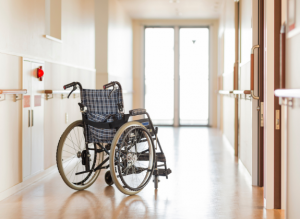
Choosing the Location of Chronic and End-of-Life Care
Updated: August 14, 2023
As people age we tend to accumulate more health problems. With an aging population this leads to more people needing a higher level of healthcare.
For some, those health issues happen earlier due to a serious illness or accident. Sometimes these problems are too much for you and/or your family to manage at home and you may need to either have professional caretakers come to your home or be admitted to a chronic care facility for medical care and/or help with personal care.
- If you are 65 years old or older, you have a 70% chance of needing some form of assistance with your care before you die.
- If you need care during that time, you have a 67% chance of needing long-term help, including a 20% chance of needing it for more than 5 years.
- The most appropriate choice will vary depending on the degree of illness, level of care needed, and the quality of the services.
- A healthcare provider will help choose which option is best for your situation based on the level of care needed. Although you will have a say in the choice, you will need a healthcare provider’s order and each option will have requirements that must be met to be accepted.
- The nationwide need for long-term care will continue to increase as the percentage of people 65 years old and older increases.
 This is a much different decision as you approach the end of your life and are considering your preference for the setting where you want your death to occur. The decision is not about the medical care necessary to improve or maintain your health or the personal care that cannot be provided at home; it’s about how you and your loved ones want to experience your death.
This is a much different decision as you approach the end of your life and are considering your preference for the setting where you want your death to occur. The decision is not about the medical care necessary to improve or maintain your health or the personal care that cannot be provided at home; it’s about how you and your loved ones want to experience your death.
- Although you may still need a healthcare provider’s order, this is a more intimately personal decision than one about chronic care services.
- You’ll want to choose a location you’re confident will comply with your advance directives, avoid unnecessary care, and maintain dignity.
- While you are cognitively aware, any decision about medical treatment is yours and must be complied with.
- When you are no longer able to make your own decisions, hospitals and nursing homes try to honor advance directives, but unwanted care, including IVs and attempts at resuscitation, may happen.
- In hospital settings, your healthcare proxy or family may be tempted to request different types of care.
- You’ll want to consider your family’s ability to access your room, since most medical care and assisted living facilities will have specific visiting hours, unless the facility will waive the restriction as you near the end of your life.
When seeking chronic or palliative care it’s important to consider your level of comfort with the caregivers, ability to communicate well with them, the level of care they can provide, and their COVID-19 vaccination status. Whether it is your home or a care facility you must consider your needs, the cleanliness of the living situation, and COVID-19 screening and other precautions in place. This will apply to your family if they are making the decision.
A significant proportion of the money spent at the end-of-life goes to healthcare. About $430 billion per year is spent on end-of-life care and hospice costs and constitutes about 10% of overall healthcare spending. If you can, compare prices and consider different options to reduce cost, especially chronic care facilities. You should choose which option is best, but try to avoid paying for more care than is necessary.
Comparing Locations of Care
| Concern | In-home Care | Hospice Facility | Nursing Homes | Hospital |
|---|---|---|---|---|
| Cost |
|
|
|
|
| Setting |
|
|
|
|
| Privacy |
|
|
|
|
| Care |
|
|
|
|
| Caretakers |
|
|
|
|
| Decisions |
|
|
|
|
| * Most of this cost covered by Medicare and other insurances | ||||
Other options include continuing care retirement or life care communities and board and care homes.
Resources
- CaringInfo, a program of the National Hospice and Palliative Care Organization, can help in finding these services.
- Fox M. How to Pay for Long-term Care. CNBC website.
- Holmes T. How to Pay for Long-Term Care When You Are Not in Perfect Health. AARP.
- Lake R. How to Plan for Medical Expenses in Retirement. Investopedia website.
- Medicare.gov – Find & compare nursing homes, hospitals & other providers near you.
- Understanding Long-Term Care. AARP.
- U.S. Administration on Aging – eldercare locator.
- Other websites include:
- Choosing Where to Die. National Care Planning Council website. Posted: February 20, 2018. Accessed: August 14, 2023.
- Different Care Settings at the End of Life. National Institute on Aging website. Updated: January 31, 2022. Accessed: August 14, 2023.
- Edwards E. More people are choosing to die at home, instead of in a hospital. NBC News website. Published: December 11, 2019. Accessed: August 14, 2023.
- Harrar S, Eaton J, Meyers H. 10 Steps to Reform and Improve Nursing Homes. AARP website. Published: January 13, 2021. Accessed: August 14, 2023.
- In-Home Care: Helping Loved Ones Age in Place. AARP website. Updated: November 19, 2021. Accessed: August 14, 2023.
- Jean S. The Talk: Discussing Future Housing Arrangements With Older Adults. Published: October 31, 2022. Accessed: August 14, 2023.
- LeaMond N. Immediate Action Needed on Long-Term Care Reform. AARP website. Published: June 17, 2021. Accessed: August 14, 2023.
- Looking after a dying loved one at home? Here’s what you need to know. The Conversation US website. Posted: October 31, 2017. Accessed: August 14, 2023.
- Milliken M. End-of-Life Care and Hospice Costs Debt.org website. Updated: June 16, 2023. Accessed: August 14, 2023.
- Morrow A. How to Prepare for Death in Your Own Home. verywell health website. Updated: March 2, 2020. Accessed: August 14, 2023.
- Morrow A. What Is Hospice Care? verywell health website. Updated: May 1, 2023. Accessed: August 14, 2023.
- Nania R. More Americans Are Choosing to Die at Home. AARP website. Posted: December 19, 2019. Accessed: August 14, 2023.
- Paulin E. 10 COVID-19 Questions to Ask a Nursing Home AARP website. Updated: October 17, 2022, 2022. Accessed: August 14, 2023.
- Temkin-Greener H, et al. Impact of Nursing Home Palliative Care Teams on End-of-Life Outcomes: A Randomized Controlled Trial. Med Care. 2018 Jan;56(1):11-18.
- Temkin-Greener H, Mukamel D, Ladwig S, et al. Do Palliative Care Teams in Nursing Homes Improve the Quality of End-of-Life Care for Nursing Home Residents? Washington, DC: Patient-Centered Outcomes Research Institute (PCORI). Accessed: August 14, 2023.
- The Five Types Of End-Of-Life Housing And Care. everplans website.
- A Complete Overview Of In-Home Care. Accessed: August 114, 2023.
- Should You Live In A Nursing Home? Accessed: August 14, 2023.
- Should You Live In An Assisted Living Facility? Accessed: August 14, 2023.
- Welcome To The World Of Palliative Care. Accessed: August 14, 2023.
- What You Need To Know About Hospice Care. Accessed: August 14, 2023.
- Why You May Not Be Able To Die At Home, Even If You Want To. everplans website. Accessed: August 14, 2023.
- Zuckerman R, Stearns S, Sheingold S. Hospice Use, Hospitalization, and Medicare Spending at the End of Life. J Gerontol B Psych Sci Soc Sci, 2018, Vol. 73, No. 4, e37–e38.





